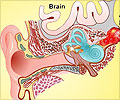Tinnitus is understood as the perception of noise in the ears or inside the head although there is no external source of sound, without any vibratory cochlear activity taking place
Tinnitus is understood as the perception of noise in the ears or inside the head although there is no external source of sound, without any vibratory cochlear activity taking place (which occurs when an external noise is produced). It is estimated that between 10 and 17% of the population has suffered tinnitus at some time in their lives, according to a number of international studies.
Depending on the intensity of the symptom, the patient may have their everyday life affected. In extreme cases the discomforts may make working routines impossible or negatively affect normal daily life.Doctor Heitzmann has recommended TRT (Tinnitus Retraining Therapy) treatment – based on the neurophysiological model - for those suffering from tinnitus. She points out that it is a treatment the aim of which is to get the patient to become accustomed to the “noise”. To achieve this, therapeutic advice and sound therapy are used.
The father of TRT is professor Pawel J. Jastreboff, who has defined tinnitus as a phantom auditory perception perceived only by the person. On applying the neurophysiological model in the University Hospital (of Navarre), Ms Heitzmann concluded that getting used to the tinnitus and thereby, achieving the cessation of discomfort, occurred in between 80 and 84% of patients, including, at times, a higher proportion. It is the treatment that has the highest success rate currently.
Other therapeutic methods, such as pharmacological ones, help to control the effects produced by tinnitus, such as anxiety and stress, but do not solve the problem, itself. Surgical operations have also shown to be of limited application for this disorder.
Various origins Tinnitus may be triggered by various factors: from a wax plug in the ear or infection in the middle ear, to hearing loss or a benign tumour. Nevertheless, the origin of the problem mostly lies in the ear itself and in the internal auditory passage.
Nevertheless, knowing the possible origin of the tinnitus has not often been helpful in identifying its treatment. Ear specialists must always undertake a diagnosis. But, in the case of tinnitus, the diagnosis is more often than not one of exclusion. The specialist has to discard other pathologies in order to discern if the noises come from the ear itself or not.
Advertisement
Getting used to noise With the application of the TRT neurophysiological model, what is important to know about the tinnitus is the manner in which the noise is made, from the peripheral organ (the ear) to the cerebral cortex. There is a series of structures in the central nervous system (CNS) that gives the tinnitus a magnified role.
Advertisement
This is why the approach proposed by Jastreboff and which we apply at the University Hospital is based on getting the patient to become used to the noise to the point where the tinnitus ceases to be a nuisance.
In this sense, the specialist believes that the disappearance of the tinnitus in itself is not the important thing, given that, on many occasions, we cannot avoid the ear hearing a noise or the auditory canal transmitting it.
Dr Heitzmann points out that when we speak of “getting accustomed” to something, we mean ceasing to be conscious of the presence of a stimulus, something which is achieved if we learn to consider it irrelevant or not to take any notice of it. It is something similar to the clothes we wear – normally we are not constantly aware of what we have on and it does not bother us.
So, getting used to the noise is synonymous with ceasing to be conscious of the tinnitus when one does not take any notice of it. Or, when notice is taken of it, and so the tinnitus is perceived, it does not cause discomfort or annoyance and is quickly forgotten.
Doctor Heitzmann considers that perceiving a tinnitus does not mean anything of significance, once diagnosed and when it does not present a vital risk to the patient and he or she does not need any other treatment.
This is confirmed by the fact that there are many who are aware of tinnitus, but are not at all bothered by them. The well-known experiment by Heller and Bergman in 1953 had already shown that all of us perceive tinnitus in specific situations with no obvious illness involved and, so, in principle, it is a symptom that is frequent and irrelevant.
Therapeutic Advice and Sound Therapy In working on TRT, Jastreboff showed that the central nervous system (CNS) has an elasticity and capacity for learning. The fact the tinnitus generates annoyance means that the CNS processes it as an important sound. We can teach the system to stop processing it at this level of importance and leave it at a subconscious level. This goal is achieved in two ways: therapeutic advice and sound therapy, fundamental tools in TRT.
Through therapeutic advice, the specialist gives the patient an explanation of what is happening and the cause of the discomfort being triggered, always after undertaking an assessment using questionnaires and clinical records, together with an auditory examination and study and, if deemed necessary, with complementary tests. An overall evaluation of the patient is essential.
The aim of therapeutic advice is to help to minimise the importance of the tinnitus. It involves eliminating the negative significance that makes the sound pass to a conscious level in the patient and cause discomfort. In this way, “disconnecting” the limbic system is achieved and the negative emotion or reaction is eliminated little by little.
Therapeutic advice is carried out over a number of interviews between the specialist and patient. Doctor Heitzmann underlines the importance of these sessions, pointing out that, without these interviews, sound therapy will not produce results.
The second TRT tool, sound therapy, arose from the discovery that, depriving the auditory passage, designed for hearing, of sound, tends to increase the sensitivity of the ear. In such a way that, when a sound – such as a tinnitus - is produced in the passage, it captures it straight away.
To avoid this phenomenon, external sound is introduced into the auditory canal, thus reducing the perception of the tinnitus at a cortical level (in order to be less conscious of what there is and distract attention away from the tinnitus by means of this external sound).
Sound therapy, thus aims at helping the patient to get used to the tinnitus, by incorporating external sound in such a way that silence is always avoided. It has various levels of application. On the one hand, all patients are advised to avoid silence at all times, using this external source of sounds.
Moreover, some patients require sound generators that emit white (neutral) sound and that have to be inserted in the ears for 8 hours a day, the noise never masking the tinnitus. Other patients with auditory loss need an adaptaiton to the headphones. The application of the therapy must always adapt to the circumstances and needs of each person.
The time estimated in getting the patient accustomed to the tinnitus and the disappearance of the discomfort depends on a number of factors, such as how long the tinnitus has taken to evolve, the psychological profile of the patient, personal circumstances that and other pathologies.
All these factors can contribute to the getting used to the acufeno being achieved within a year, a year and a half or two years (the average estimated period) although these times may be longer, due to the factors mentioned. Not achieving the target in this time is thus not considered a failure. To help in the process, monitoring is required involving 5-6 clinical visits over 2 years, although this can vary according to the individual.
Source-Eurekalert
JAY/M











